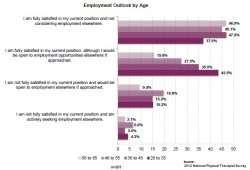 Physical therapists are the new nurses of healthcare recruiting, so much in demand that help-wanted ads for them are now among the most commonly advertised healthcare jobs online.
Physical therapists are the new nurses of healthcare recruiting, so much in demand that help-wanted ads for them are now among the most commonly advertised healthcare jobs online.
In fact, Wanted Analytics reports there are now more jobs advertised for physical therapists than any other job in any occupation, exceeding even those for nurses, which have held the top spot for years. And that’s after accounting for a 26 percent year-over-year decrease in the number.
Now a survey done by CKR Interactive’s Peer Group U.S. and healthcare marketing specialist Katon Direct helps explain why it’s so difficult to fill physical therapist openings. Besides simply the growing demand for those services, professionals in the field simply don’t want to change jobs.
“Only 4.1 percent of survey respondents say they are currently looking for a new job,” according to the 2012 National Physical Therapist Survey. That’s far less than the 38 percent of all workers a Globoforce survey said were looking. And it’s less than half the national unemployment rate.
It would be wrong to read too much into the specific numbers. Of the 185,000 or so physical therapists counted by the U.S. Bureau of Labor Statistics, only 309 completed the survey. Still, as the report notes, the results do suggest trends and offers some insights for recruiters into the challenges in sourcing and placing candidates.
For instance, 30.7 percent of the professionals said that while they are satisfied working where they are, if they were approached, they’d consider switching employers. But it won’t be an easy sell. Money takes a back seat to reputation, brand, and location.
Out of 20 attributes respondents were asked to score (on a 1-5 scale), having a reputation as a great place to work scored 4.62, the highest. Close behind was the employer’s reputation for medical excellence with a 4.55.
Location ranked third, not surprising since three-quarters said they would not relocate to take a another job.
When they do decide to make a change, physical therapists turn to their friends and colleagues. Career sites and professional publications are important, but less so. And when it comes to using social media to recruit them, physical therapists are “ambivalent,” says the report. Just over half say they don’t think it’s appropriate for an employer to connect with them on any social media platform,
Yet, more than 7 in 10 physical therapists are social media users, with the majority spending time on Facebook. They are on other sites, including LinkedIn and Google+, but in far fewer numbers. Of those who are OK with being contacted, LinkedIn is by far the preferred method.
As demand grows for physical therapists — and the BLS says it will grow by 39 percent in the 10 years to 2020 — hiring will become more difficult. With pay important, but less so than other factors — the average salary is almost $80,000— employers will have to take a hard look at their work environment, and especially at their brand and reputation, says the report.
You may not be able to influence those who want only to work for a certain type of employer (health systems and hospital outpatient facilities rated highest on the desirability list), but, says the report, “Your brand can make or break your ability to attract physical therapists to your organization.”